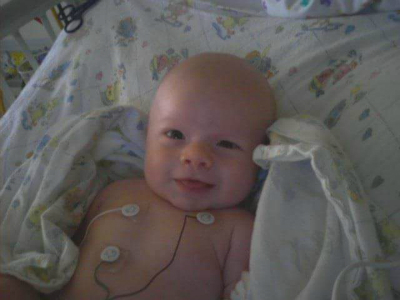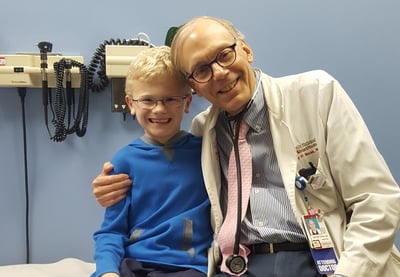
Aidan's Story

“Our pediatrician hovered over Aidan’s heart for way too long,” said Stephanie Mohun-Hintze, Aidan’s mom. “I knew something was wrong.”
During his 1-month-old checkup at a local doctor’s office in California, Maryland, Aidan’s pediatrician detected a rapid heartbeat. He immediately sent them to Children’s National where doctors confirmed that Aidan’s tiny heart was beating twice as fast as it should be.
Jeffrey Moak, M.D., Director of the Electrophysiology and Pacing Program within the Children’s National Heart Institute, diagnosed Aidan with a rare heart condition called Wolff-Parkinson White syndrome (WPW). Normally, electricity in the heart flows from the top chambers (atria) to the bottom chambers (ventricles) and is then extinguished, similar to a one-way road. In WPW, there is an extra, microscopic string of tissue that connects the upper and lower parts of the heart, creating a complete circuit that allows electrical currents to spin faster and faster.
“It’s sort of like a merry-go-ground,” says Dr. Moak. “It causes a form of reciprocating tachycardia involving the atria and ventricles, in other words a very rapid heartbeat.”
Typical symptoms for WPW include chest pain, dizziness, lightheadedness and pale or ashy skin. The scary part for Aidan’s family was that he didn’t have any symptoms before diagnosis or in the years to follow. “It was a complete shock,” remembers Stephanie.
The two primary ways to treat supraventricular tachycardia (SVT) are with medications that suppress the arrhythmia or with cardiac ablation, which uses targeted energy to destroy just the area of the heart causing the abnormal heartbeat. During an ablation, an electrophysiologist inserts a catheter (flexible tube) into a blood vessel and threads it into the heart.
“To safely and accurately target the microscopic pathway – and minimize patients’ exposure to radiation from x-rays – we use a radiation-free, 3-D mapping technology that allows physicians to precisely guide catheters during ablations. Once the origin of the issue is located, we send electrical impulses through the catheter to burn the tissue so it can no longer conduct electricity.”
Since catheters are designed primarily for use in adults, Dr. Moak and his team decided to treat Aidan’s condition with medication until he grew older. Over the next few days, they worked to finalize the best combination of medications to control his SVT. But his case proved to be more challenging than anyone had hoped or expected. Because he grew so quickly, doctors needed to continually adjust his medications to keep him from experiencing more episodes. In the first year, Aidan was admitted to Children’s four more times for SVT.
“We gave him medication every eight hours for the next six years. It changed the way we lived our lives,” says Stephanie. “We made special trips to his daycare center to make sure he was given his meds at just the right time. We tried to keep him away from children who were sick, as the flu or fever could put him over the edge and cause SVT. We are so thankful for our team at Children’s – especially during that time. They even taught us how use a stethoscope to check his heart rate at home in case we ever worried.”
Many children outgrow SVT, so in February 2015 when Aidan was 6 years old, the family and Dr. Moak decided to wean him off of his medications. Eight weeks later, however, he had another episode and was scheduled for an ablation to permanently resolve the issue.
The ablation was a success, but during Aidan’s two-month follow-up appointment, an electrocardiogram showed that the pathway had returned. This is more common for patients like Aidan, whose extra pathway is on the right side of their hearts. In September 2015, Dr. Moak performed the final ablation, curing Aidan of his WPW for good.
“We feel very fortunate to have had Dr. Moak and his fantastic team – Beth, Vicki and Carol – caring for Aidan for the last eight years,” said Stephanie. “Even though we live 50 miles from the hospital, it feels so close. We had a fantastic experience with Children’s.”

“It was a pleasure to care for Aidan and his moms,” says Beth Jarosz, R.N., M.S., electrophysiology nurse clinician. “Aidan’s SVT was complex, leading to several hospital admissions, often several days to a week at a time, in the first years of his life. His medications required numerous adjustments over the years, each followed by a 24-hour home monitor. Despite this, Aidan, Stephanie and Denise always took things in stride and kept a positive attitude and resilient spirit!”
“It was a delight to care for Aidan,” says Dr. Moak. “He and his family always kept positive attitudes and were very supportive and engaged in his medical care. I look forward to seeing all that Aidan will accomplish in the future.”



